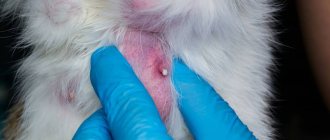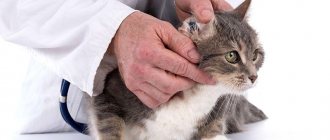12478Administration
The health of the pet always comes first for the owner. In cats and cats, it is the ears that are a common cause of anxiety; their diseases cause a lot of unpleasant moments for the animal. If he shakes his head, scratches his ears, or there is discharge, then you should definitely show your pet to a doctor.
Many diseases can have serious consequences, so do not delay a visit to the veterinary clinic. You can only guess on your own, and we will tell you what symptoms and treatment of ear diseases in cats exist. But you should not self-medicate.
What ear diseases affect cats?
Most ear diseases are caused by parasites and mites. The next group is various inflammatory processes, accompanied by unpleasant diseases , such as infectious and inflammatory processes, otitis media and other ear diseases. There are also post-traumatic problems. Ear diseases in cats can be roughly divided into several groups:
- Otodectosis. The cause is the scabies mite, which parasitizes inside the ear canal and inner ear area. This is an extremely contagious and serious disease that requires mandatory treatment;
- Otitis and other diseases of the external and internal ear;
- Eczema and dermatitis;
- Hematomas and abscesses. Are a consequence of injuries;
- Neoplasms of various origins and tumors;
- Necrosis of the auricle.
Let's look at each group separately.
© shutterstock
Prevention of ear diseases in cats
Prevention of diseases accompanied by pathological discharge from the pet’s ears includes the following list of measures.
- Maintaining hygiene of the animal's external auditory canal.
- Protecting your pet's ears from injury, mechanical damage, water, foreign objects and other negative influences.
- Regular examination of the auricle to detect redness, crusts, scratches, seals, areas of inflammation, etc.
- Regular disinfection of cat housing, care items, and toys.
- Suppression of contacts with homeless relatives.
- Timely antiparasitic treatment of all pets living in the house.
The last point is especially important! Antiparasitic treatment of pets is carried out regardless of access to the street. After all, ticks can enter the apartment on the owner’s shoes or clothes. Stronghold drops on the withers will provide reliable protection against them. After applying them for a month, even during a walk, your cat will not be afraid of ear parasites.
Otodectosis
Parasites of various kinds always cause a lot of unpleasant moments for furry friends.
Ear diseases in cats are in most cases caused by ear parasites - scabies mites.
The ways and reasons for getting them into the ears of pets are quite difficult to explain. Most often this happens on a walk or from the clothes of the owners, that is, it is quite easy to get a tick from the outside. But treatment, as a rule, requires effort and thoroughness from both the pet and the owner.
A few days after infection are enough for the first symptoms of the disease to appear. You will immediately notice the restless behavior of the animal, which begins to constantly scratch its ears with its paws, as well as shake and shake its head.
The cat seems to want to shake out the nuisance, but cannot. Her ear is constantly itching and causing a lot of trouble.
If you notice this behavior, you should conduct a careful and thorough examination of the ear, which is best done while wearing sterile gloves. Ticks always leave marks and other visible signs indicating their presence, such as a brown coating. The so-called passages - thin wounds - will also alert you.
Please note that self-medication of diseases is extremely dangerous. Mite infestations often result in more serious problems, causing ear diseases.
The most common complication is otitis media. To prevent this from happening, urgently take your pet to a veterinary clinic. Only a doctor can accurately diagnose and prescribe adequate treatment that will help your cat quickly get rid of ticks without consequences.
Signs of ear problems
Normally, cats' ears are shiny and clean, but not wet. The skin inside the ear is a uniform pale pink color. There is no visible discharge in the ear; at most, there may be a small accumulation of light yellow wax without a strong odor. If a kitten develops an ear disease, it will manifest itself with some of the following symptoms:
1. The cat shakes its head and purses its ears. 2. The cat actively scratches its ears and even scratches them until they bleed, resulting in crusts and wounds appearing. 3. There is no (or weakened) reaction to sounds. 4. If you touch the ears at the base, the cat presses them and tries to escape, bites and scratches. 5. Swelling, unnatural growths and bumps are found inside.
Read more: The cat has a swollen ear: what to do
6. The skin in the ear is red, peeling, there are signs of inflammation and crusting. 7. Discharge in the ears ranges from whitish to dark brown. 8. A putrid or sweetish (unnatural) odor comes from the ears. 9. Shortness of breath and nasal discharge are observed. 10. There may be problems with motor coordination and balance.
Otitis
Otitis is an inflammatory process that occurs in the inner, middle or outer ear of both humans and animals. In cats, it is often a complication of otodecosis. The most dangerous is damage to the inner ear. If left untreated and the disease progresses, the inflammatory process can affect internal tissues , and then lead to the animal becoming hard of hearing or losing hearing completely, as well as having problems with the vestibular system.
© shutterstock
Having discovered that discharge has appeared from the ear, you can definitely say that your pet has otitis media. This is the main symptom of ear disease. They may be clear or contain pus. It is especially dangerous when they acquire an unpleasant odor.
Most often, inflammation causes inflammation in a cat:
- uncomfortable state
- decreased activity
- loss of appetite.
Rarely does otitis media go away without visible discharge, but discharge from the ear is always present. As with the primary infection with ticks, you may notice that the cat seems to want to rid itself of the object that is bothering it, shaking its head and tilting its ear towards the diseased ear.
If the owner does not take action in time and does not begin treatment, the disease can go deeper and lead to the most difficult consequences.
Problems with coordination and an increase in body temperature are very alarming bells for the owner and a reason to immediately seek qualified medical help.
The cause of the disease can be not only infection with ticks, but also hypothermia. You can prevent it if you protect your cat from drafts in cool weather and dry it thoroughly after bathing.
There is no point in prescribing treatment for your pet on your own. Only a veterinarian can make an accurate diagnosis and select the correct drug treatment that will suit your cat individually.
When to contact a veterinarian
Cat owners need to be very careful and monitor the slightest changes in the behavior and health of the animal. The following signs should alert you:
- itching that causes your pet to scratch its ear;
- lethargy and weakness;
- increased body temperature;
- presence of a wound or other change in the ear;
- the appearance of any suspicious discharge from the ear.
You should contact the clinic even if even the smallest foreign body gets into your ear. Remaining in it, it can cause infection and a pronounced purulent abscess.
Hematomas and abscesses
Both of these ailments are the result of trauma to the animal. In general, their symptoms are similar, as are the reasons why they appear in a cat. Often, without proper treatment, a hematoma can develop into an abscess.
Cats that are let outside by their owners often suffer mechanical damage to the ear. This can be especially observed with the onset of spring, when cats fight for the attention of cats, or simply do not divide the territory. The pet returns home with various injuries, both open wounds and bruises.
© shutterstock
A hematoma is a closed type injury, simply a bruise. As we know, it appears from various blows. Just like a person, the bruised area hurts a lot. Most often, cats' ears are susceptible to hematomas, so it is quite easy to see a bruise, since the animal has less hair on them.
If your pet is acting restless, screaming and pressing its ear, carefully examine it. Often he won't even let you touch him. This is a clear reason to see a doctor.
An abscess is a consequence of an open injury, purulent inflammation. Any scratch can lead to an abscess. Ears are damaged during fights; cats often injure them with each other's claws. Since they always contain dirt, sand or dust, they get into the wound. After your cat has visited the street, you must carefully examine him for scratches and carefully treat the wounds on his ears with disinfectants. If this is not done, the injury site may swell, turn red and fester. Here you can handle it yourself, if the affected area is small, treat it with iodine and disinfect it. But it's better to show it to a doctor. The veterinarian will open the abscess on the animal's ear and remove the pus.
Injuries and wounds
A street fight for territory, a bite or independent, careless scratching can cause suppuration and inflammation.
You can treat the damaged areas yourself and seek help from a veterinarian who will carry out antibacterial treatment of the damaged area.
Tumors and neoplasms
Ear tumors in animals are extremely rare. It is not possible to notice and recognize them in the early stages. Only fairly large tumors can be noticed, and then consultation with a specialist is definitely needed to find out the origin of the tumor. The dangers facing growing tumors include:
- hearing loss,
- vestibular disorder.
Often in such cases the help of a surgeon is required.
Symptoms of ear diseases in cats
Although all ear diseases in cats differ in symptoms, there are also some standard signs. It is important to know that any of them is a reason to contact a veterinary clinic for qualified help.
Here are the typical signs of ear disease in cats:
- the pet scratches its ears, this is caused by discomfort,
- tilts his head to the side, rubs his ear against the surface, tries to shake off or remove something,
- discharge is observed,
- the animal has a lethargic appearance, loss of appetite, no playful mood,
- body temperature rises,
- wounds, purulent formations or tumors are visually visible.
How to help an animal
Hot ears in a cat are not a pathology in themselves, which means that trying to cool only one ear (for example, by applying ice compresses) is pointless. The first thing to do is to examine the animal for other symptoms. If they are not there, then you should leave the cat alone for 20–30 minutes and feel the ears again - in a healthy animal, by this time the blood flow will normalize and the skin will no longer be hot.
When fiery ears are still a symptom of some kind of disease, it is necessary to begin treatment. It depends on the diagnosis:
- If the ears are burning due to severe stress, then first you need to create the most comfortable conditions for the cat and remove all irritants. There is no need to forcefully try to pick up the animal or stroke it (this will only increase the stress). It is better to provide maximum peace, but leave water and tasty food nearby. If after a couple of days the cat’s mental well-being is not restored, veterinarians will prescribe sedatives: Clomipramine;
- Cat Baiyun;
Kot Bayun is a sedative medicine based on natural herbal ingredients
- Fitex;
- Vetspokoin;
- Anti-stress;
- Phospasim;
- Vetranquil.
- Surolan;
Amitrazine is a veterinary drug that is used for cats in the treatment of pathologies caused by sarcoptic mites
During treatment of otitis media, ear mite infection, and after surgery, the cat must be wearing a medical collar that prevents the animal from scratching the sore ear.
If the cat has a fever
If the ears are hot, you need to make sure that the animal’s body temperature is normal. If you don’t have a thermometer, just feel the animal’s nose - it should be cold and wet when awake. If you have a temperature measuring tool at home, you should use it. For an adult cat, readings below 37.5˚C and above 40˚C are a serious reason to immediately contact a veterinarian. Fever occurs when:
- infectious diseases;
- poisoning;
- tumors;
- allergies.
Video: how to correctly measure a cat's temperature
Sometimes an emergency situation arises when it is impossible to quickly get an appointment with a specialist. Inaction during hyperthermia is dangerous, therefore the following measures are allowed to eliminate fever:
- Cover the animal for a couple of minutes with a towel soaked in cold water (do not put the cat in an ice bath, as this can cause heart attacks).
- Give the cat echinacea tincture at the rate of 1 drop per 1 kg of animal weight (dilute the drug with water in a ratio of 1:5).
- Place the antipyretic suppository Cefekon (50 mg for an adult cat, 25 mg for a kitten).
Remember, fever is a dangerous symptom. Even if you manage to knock it down, it is very important to take your cat to the vet as soon as possible. He will conduct an examination and find out the exact cause of the fever, which will help prescribe the correct treatment.
Many cat owners panic if their pets' ears become hot. But, according to experts, flaming ears themselves are not a reason to suspect a disease. You need to worry if the animal's general body temperature rises, it itches constantly, refuses to eat, and sleeps poorly. Such symptoms are already a reason to visit a veterinarian, find out the reason for the cat’s poor health and immediately begin treatment.
Treatment
First you need to carefully examine the animal's ears and try to understand what happened and what is bothering him. Making a correct diagnosis and identifying the cause of ear diseases in a cat is a sure way to a quick cure without unpleasant consequences. If it is a small wound, the owner can cope with the disease himself. But in more serious cases, only a doctor will help.
© shutterstock
Veterinary pharmacies have a number of drugs with different spectrums of action that help in the treatment of various ear diseases in cats. Remember an important point: cleaning your ears with cotton swabs is strictly prohibited . All discharge and dirt from the auricle are removed only with cotton pads.
Abscesses, hematomas, necrosis, tumors must be shown to a doctor who will decide on treatment of the disease and surgical intervention.
If any tiny thing or foreign body gets into the ear canal, it is also removed in the clinic. If left for a long time, it can cause an inflammatory process. Treating your cat's ears should not be delayed.
Diagnostic activities
If your cat's ear stinks and there is unpleasant discharge, you should consult a veterinarian. Such a violation is the result of a serious infection and other dangerous diseases. To determine the source of the problem, laboratory and instrumental examinations are carried out. To examine the ear canal, the veterinarian uses an otoscope, through which it is possible to identify inflamed areas and the extent of the disorder. During diagnosis, the following facts are revealed:
- presence/absence of foreign objects in the ears;
- benign or malignant neoplasms;
- condition of the eardrum.
If certain pathologies are suspected, a smear is taken from the cat's ear, followed by laboratory examination under a microscope. Thanks to this diagnostic procedure, it is possible to identify bacteria, fungi and other pathogenic microorganisms that may cause an inflammatory reaction. After a comprehensive examination, hormonal, antiallergic and other medications are selected, after taking which the cat’s ear will stop leaking.










